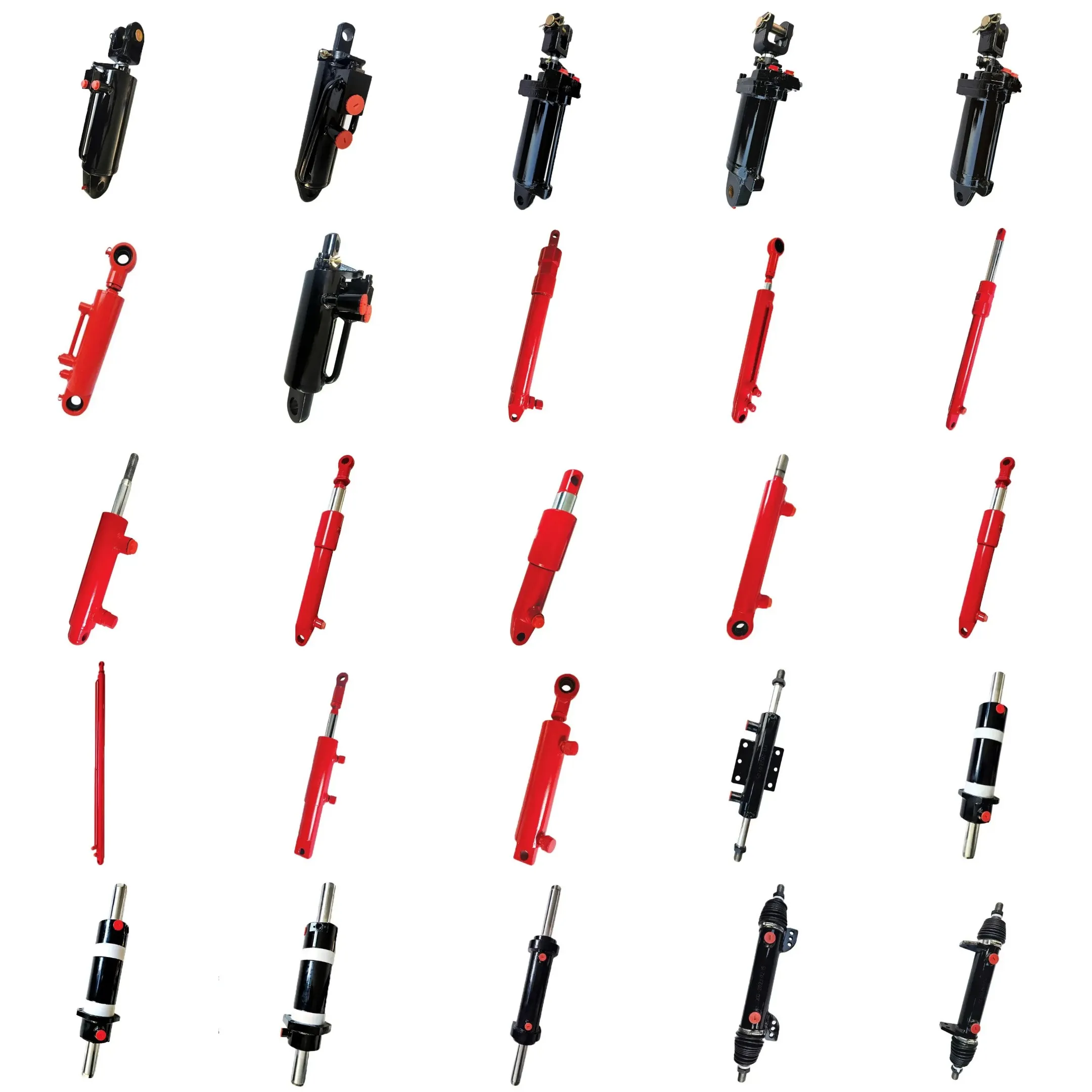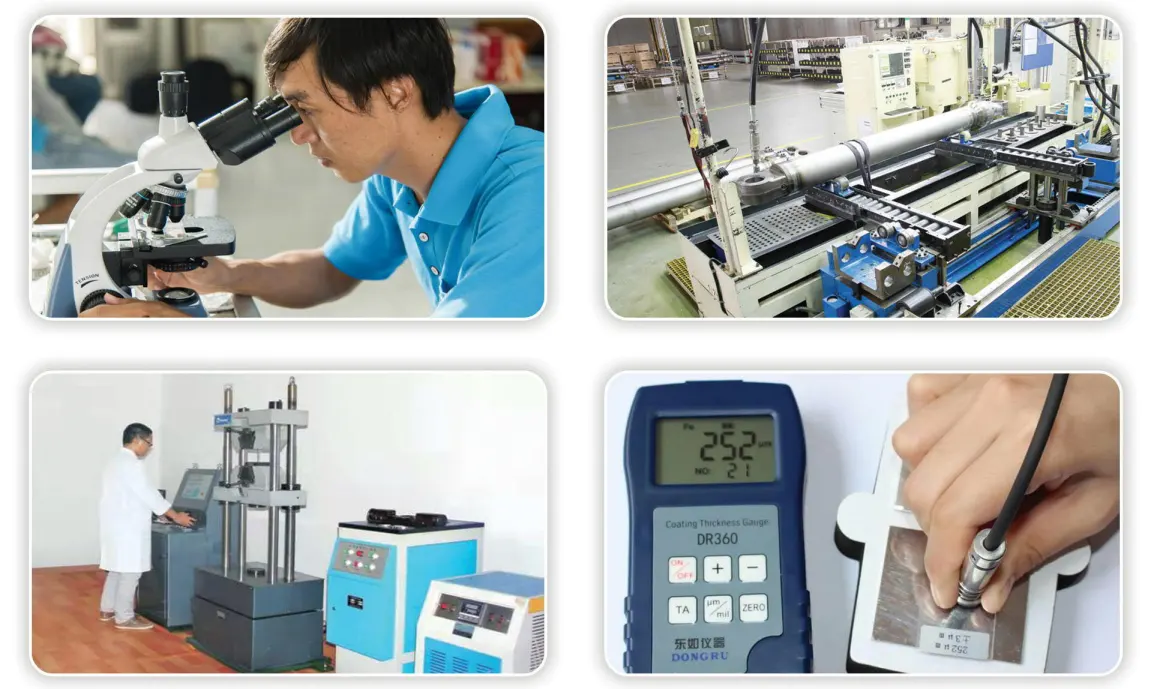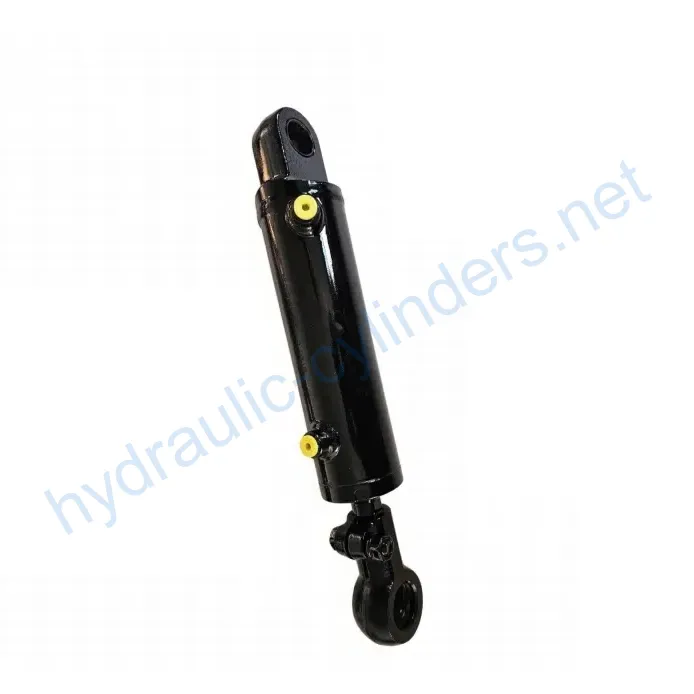Forklift Truck Tilt Cylinder
Forklift Truck Tilt Cylinder
Product Introduction
The Forklift Truck Tilt Cylinder is a vital component in the hydraulic system of a forklift, enabling the adjustment of the mast??s angle for optimal load handling. This hydraulic cylinder plays a crucial role in lifting, lowering, and tilting the front forks, allowing for precision in handling various loads. It consists of a cylinder housing, a piston, and a rod, all designed to withstand high pressure and provide smooth operation. The tilt function helps maintain stability during lifts, ensuring safety and efficiency in warehouse operations. With a reliable tilt cylinder, forklift operators can maneuver loads more effectively, significantly reducing the risk of accidents and enhancing productivity in material handling.
Product Specifications
Cylinder Diameter
The cylinder diameter measures 70mm, which contributes to the cylinder’s overall strength and ability to handle substantial loads.
杆直径
The rod diameter of 32mm ensures durability and resistance to bending and buckling under heavy loads.
Travel Distance
With a travel distance of 167mm, this cylinder provides adequate movement for effective tilt adjustments.
Installation Distance
The installation distance of 455mm allows for compatibility with various forklift models, making it easier to integrate into existing systems.
Product Features
- High durability due to robust materials used in manufacturing.
- Exceptional performance in heavy-duty applications.
- Customizable options are available to meet specific requirements.
- Easy installation and maintenance, ensuring minimal downtime.
- Designed for optimal safety and efficiency in operation.
Application Scenarios
Warehouse Operations
In warehouse environments, the Forklift Truck Tilt Cylinder facilitates efficient loading and unloading of goods. By adjusting the angle of the forks, operators can safely stack items at various heights, improving space utilization. This functionality reduces the risk of product damage and enhances overall workflow efficiency.
Construction Sites
At construction sites, this hydraulic cylinder is essential for lifting heavy materials such as steel beams and concrete blocks. The ability to tilt the forks allows operators to position loads accurately, which is crucial when working on uneven surfaces or in tight spaces, ensuring safety and precision in material handling.
Transport and Logistics
In the transport and logistics sector, the tilt cylinder aids in the efficient loading of trucks and containers. By enabling the adjustment of fork angles, it ensures that loads are balanced and secure during transportation, reducing the likelihood of accidents during transit.
Design Considerations and Selection Criteria
Load Capacity
When designing the Forklift Truck Tilt Cylinder, load capacity is paramount. It must be able to handle the maximum weight of the loads it will lift. Engineers must calculate the expected forces and factors in safety margins to ensure that the cylinder remains operational under various conditions. A robust design prevents failures that could lead to accidents or damage to materials.
Sealing Mechanism
Sealing is crucial to prevent hydraulic fluid leakage and maintain pressure within the system. The design includes precision-engineered seals that ensure a leak-proof environment, enhancing the cylinder??s efficiency and longevity. Seals must withstand varying temperatures and pressures while providing reliable performance over time.
Durability
Durability is a key consideration in the design of hydraulic cylinders. The materials used must resist wear and tear from continuous use in demanding environments. High-quality metals and coatings are employed to protect against corrosion and abrasion, thereby extending the lifespan of the cylinder.
Safety Features
Safety features are integral to the design of the Forklift Truck Tilt Cylinder. These may include pressure relief valves and safety locks that prevent accidental tilt adjustments while the load is lifted. Such mechanisms protect operators and bystanders, ensuring safe operation during use.
Maintenance Accessibility
Designers also consider maintenance accessibility to ensure that routine checks and repairs can be performed quickly and efficiently. This includes easy access to seals and lubricants, allowing for timely maintenance that minimizes equipment downtime and extends the lifespan of the cylinder.
Sealing and Lubrication
The effectiveness of the Forklift Truck Tilt Cylinder is greatly influenced by its sealing and lubrication systems. Various sealing components, such as piston seals and rod seals, are utilized to maintain hydraulic integrity. These seals are often made from durable materials like polyurethane and nitrile rubber, which resist wear and provide reliable performance. The cylinder body and threaded ends undergo precision machining to enhance wear resistance, ensuring that the surfaces can withstand the rigors of operation.
Regular lubrication is crucial to maintaining optimal function. Operators must ensure that adequate hydraulic oil is periodically added to the cylinder to prevent friction and wear on moving parts. The lubrication process not only protects the seals but also promotes smooth operation, reducing the risk of system failure.
Preventive Maintenance Measures
- Regular Inspections: Frequent inspections of the tilt cylinder are essential to identify any signs of wear or damage. This includes checking for leaks, examining seals, and ensuring the integrity of the cylinder body. Early detection of issues can prevent costly repairs and downtime.
- 润滑: Keeping the hydraulic system properly lubricated is vital for performance. Operators should follow the manufacturer’s recommendations for lubrication intervals and ensure that only high-quality hydraulic oil is used to prevent degradation of seals and components.
- 更换密封件: Over time, seals can wear out and may need to be replaced to maintain system efficiency. Operators should establish a schedule for seal inspections and replacements as part of routine maintenance to avoid unexpected failures.
Installation Guidelines
Proper installation of the Forklift Truck Tilt Cylinder is critical for safe and efficient operation. Begin by ensuring that the installation area is clean and free from debris. Align the cylinder to the designated mounting points on the forklift, using appropriate mounting brackets to secure it firmly. It is crucial to ensure that the cylinder rod is properly aligned with the forklift’s hydraulic system to avoid undue stress during operation.
Once positioned correctly, securely fasten all bolts and connections to prevent loosening during use. After installation, conduct a thorough inspection of the hydraulic connections and check for any signs of leaks. Finally, test the system at low pressure before moving to full operation to ensure that everything functions as intended.
Common Maintenance Tasks
定期检查
Regular inspections are crucial for identifying potential issues with the Forklift Truck Tilt Cylinder before they escalate. Operators should schedule routine checks to assess the condition of seals, hydraulic connections, and overall cylinder integrity. During inspections, look for any signs of fluid leakage or wear on the cylinder surface. Promptly addressing minor issues can prevent major failures and enhance operational safety.
Proper Lubrication
Proper lubrication of the hydraulic system is essential for smooth operation and longevity of the cylinder. Operators should adhere to the manufacturer’s guidelines regarding lubrication intervals and ensure that the correct type of hydraulic oil is used. Insufficient lubrication can lead to increased friction, premature wear, and potential failure of the hydraulic system. Regularly check oil levels and top up as necessary to maintain optimal performance.
Seal Replacement and Calibration Checks
Seal replacement is a critical maintenance task that ensures the hydraulic system remains leak-free. Operators should regularly inspect seals for signs of wear and replace them as needed to prevent fluid loss. Additionally, calibration checks should be performed to ensure that the cylinder operates within specified parameters, which is vital for reliable performance. This may include adjusting pressure settings and verifying that the tilt function operates smoothly without any obstructions.
Safety Considerations and Environmental Factors
When using the Forklift Truck Tilt Cylinder, adherence to safety measures is paramount. Operators must be trained to handle hydraulic equipment safely, ensuring that they understand the potential hazards associated with hydraulic systems. Proper use of personal protective equipment (PPE) is essential, including gloves and eye protection, to minimize risk during operation. Moreover, maintaining a clean work environment helps prevent accidents and ensures that all personnel are aware of their surroundings. Environmental considerations are also important; disposing of hydraulic fluids and components must be done according to local regulations to minimize impact on the environment.
Troubleshooting and Common Issues
- Hydraulic Leaks: One of the most common issues with hydraulic cylinders is fluid leakage. This can stem from worn seals or damaged components. Operators should inspect seals regularly and replace them at the first sign of wear to prevent fluid loss.
- Insufficient Lift Power: If the cylinder fails to lift loads effectively, it may indicate low hydraulic fluid levels or internal damage. Checking fluid levels and inspecting the cylinder for signs of wear can help diagnose the issue.
- Unexpected Tilting: If the tilting function operates erratically, it could be due to air trapped in the hydraulic system or a malfunctioning control valve. Purging air from the system and inspecting the control mechanisms can often resolve this issue.
Troubleshooting Tips
To effectively diagnose issues with the Forklift Truck Tilt Cylinder, operators should follow a systematic approach. Start by examining the hydraulic fluid levels and checking for leaks. If fluid levels are low, top up with the recommended hydraulic oil and monitor for recurring leaks. For issues related to insufficient lift power, inspect the cylinder for any blockages or damage, and ensure that the hydraulic system is functioning correctly.
In cases of unexpected tilting, perform a thorough check of the hydraulic lines and valves to ensure they are free from blockages and functioning as intended. If problems persist, consulting with a qualified technician can provide further insights and resolution methods.

About Our Company
We are a leading manufacturer of hydraulic cylinders, offering a comprehensive range of products to meet the demands of both domestic and international markets. With a commitment to quality and innovation, we have established ourselves as a trusted supplier in the hydraulic industry. Our expertise spans various sectors, allowing us to provide tailored solutions that cater to specific customer needs.
Our manufacturing capabilities are supported by advanced production equipment, ensuring that all products meet rigorous quality standards. We adhere to international certifications, guaranteeing the reliability and safety of our hydraulic cylinders. Additionally, we offer customized services to accommodate unique specifications, ensuring that our clients receive products that perfectly suit their applications.

Our dedicated after-sales service team remains available to assist clients with any inquiries or support needs, ensuring a seamless experience from purchase to operation. Partner with us for your hydraulic cylinder needs, and experience the difference in quality and service.
Author: lyl
参观我们的 VR 工厂
通过以下方式参观我们的 VR 工厂
液压缸应用:


